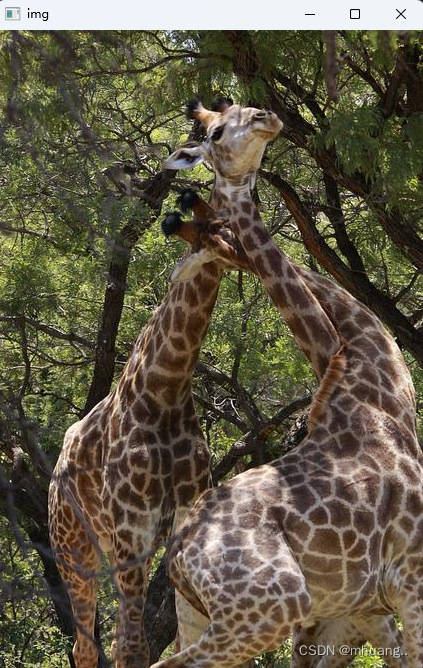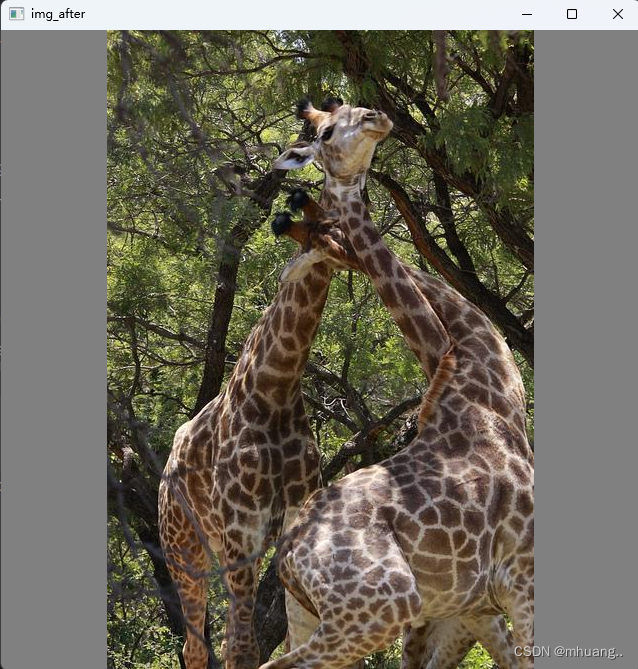最细致讲解yolov8模型推理完整代码 |
您所在的位置:网站首页 › yolo 模型大小 › 最细致讲解yolov8模型推理完整代码 |
最细致讲解yolov8模型推理完整代码
|
研究yolov8时,一直苦寻不到Yolov8完整的模型推理代码演示,大部分都是基于Yolo已经封装好的函数调用,这个网上教程很多,本文就不赘述这方面的内容了,接下来将细致全面的讲解yolov8模型推理代码,也就是yolov8的predict的前处理(letterbox缩放),后处理(坐标转换,置信度过滤,NMS,绘图)的代码实现(附完整代码)。 前处理 letterbox缩放yolov8预设的图片输入是640x640大小的,所以我们需要将一般大小的图像resize成标准大小,但是单纯的只是用resize来操作的话有可能会造成图像的失真: 原图: 所以yolov5提出letterbox缩放(v8也沿用了),其原理就是等比例缩放,其他的部分用背景色填充: 前处理代码如下: def resize_image(image, size, letterbox_image): """ 对输入图像进行resize Args: size:目标尺寸 letterbox_image: bool 是否进行letterbox变换 Returns:指定尺寸的图像 """ from PIL import Image ih, iw, _ = image.shape h, w = size if letterbox_image: scale = min(w/iw, h/ih) # 缩放比例 nw = int(iw*scale) nh = int(ih*scale) image = cv2.resize(image, (nw, nh), interpolation=cv2.INTER_LINEAR) # 生成画布 image_back = np.ones((h, w, 3), dtype=np.uint8) * 128 # 将image放在画布中心区域-letterbox image_back[(h-nh)//2: (h-nh)//2 + nh, (w-nw)//2:(w-nw)//2+nw, :] = image else: image_back = image return image_back经过前处理后得到的图像尺寸为(640x640x3),为了对应yolov8模型的输入尺寸(N,C,H,W),我们对其进行预处理操作: 数据预处理 def img2input(img): img = np.transpose(img, (2, 0, 1)) img = img/255 return np.expand_dims(img, axis=0).astype(np.float32) # (1,3,640,640)因为只是做预测,所以N取1,C为通道数3。 现在就可以放进模型里计算了,本文采用的yolov8模型是onnx格式的。 sess = rt.InferenceSession('runs/detect/train49/weights/best.onnx') input_name = sess.get_inputs()[0].name label_name = sess.get_outputs()[0].name pred = sess.run([label_name], {input_name: data})[0] # (bs, 84=80cls+4reg, 8400=3种尺度的特征图叠加), 这里的预测框的回归参数是xywh,而不是中心点到框边界的距离模型得到的输出格式为(84x8400),84=边界框预测值4+数据集类别80, yolov8不另外对置信度预测, 而是采用类别里面最大的概率作为置信度score,8400是v8模型各尺度输出特征图叠加之后的结果(具体如何叠加可以看源码,一般推理不需要管)。本文对模型的输出进行如下操作,方便后处理: def std_output(pred): """ 将(1,84,8400)处理成(8400, 85) 85= box:4 conf:1 cls:80 """ pred = np.squeeze(pred) # 因为只是推理,所以没有Batch pred = np.transpose(pred, (1, 0)) pred_class = pred[..., 4:] pred_conf = np.max(pred_class, axis=-1) pred = np.insert(pred, 4, pred_conf, axis=-1) return pred #(8400,85)得到输出(8400,85)。8400个特征图的cell,每个cell里面有4+1+80的输出值,对应4个预测框+1个置信度(最大类别概率)+80类别概率。 后处理 置信度过滤+NMS非极大值抑制接下来就对刚刚的(8400,85)进行后处理,先进行置信度过滤,再进行NMS非极大值抑制,本文将这两步筛选操作放在了一个函数中: def nms(pred, conf_thres, iou_thres): """ 非极大值抑制nms Args: pred: 模型输出特征图 conf_thres: 置信度阈值 iou_thres: iou阈值 Returns: 输出后的结果 """ box = pred[pred[..., 4] > conf_thres] # 置信度筛选 cls_conf = box[..., 5:] cls = [] for i in range(len(cls_conf)): cls.append(int(np.argmax(cls_conf[i]))) total_cls = list(set(cls)) # 记录图像内共出现几种物体 output_box = [] # 每个预测类别分开考虑 for i in range(len(total_cls)): clss = total_cls[i] cls_box = [] temp = box[:, :6] for j in range(len(cls)): # 记录[x,y,w,h,conf(最大类别概率),class]值 if cls[j] == clss: temp[j][5] = clss cls_box.append(temp[j][:6]) # cls_box 里面是[x,y,w,h,conf(最大类别概率),class] cls_box = np.array(cls_box) sort_cls_box = sorted(cls_box, key=lambda x: -x[4]) # 将cls_box按置信度从大到小排序 # box_conf_sort = np.argsort(-box_conf) # 得到置信度最大的预测框 max_conf_box = sort_cls_box[0] output_box.append(max_conf_box) sort_cls_box = np.delete(sort_cls_box, 0, 0) # 对除max_conf_box外其他的框进行非极大值抑制 while len(sort_cls_box) > 0: # 得到当前最大的框 max_conf_box = output_box[-1] del_index = [] for j in range(len(sort_cls_box)): current_box = sort_cls_box[j] iou = get_iou(max_conf_box, current_box) if iou > iou_thres: # 筛选出与当前最大框Iou大于阈值的框的索引 del_index.append(j) # 删除这些索引 sort_cls_box = np.delete(sort_cls_box, del_index, 0) if len(sort_cls_box) > 0: output_box.append(sort_cls_box[0]) sort_cls_box = np.delete(sort_cls_box, 0, 0) return output_box def xywh2xyxy(*box): """ 将xywh转换为左上角点和左下角点 Args: box: Returns: x1y1x2y2 """ ret = [box[0] - box[2] // 2, box[1] - box[3] // 2, \ box[0] + box[2] // 2, box[1] + box[3] // 2] return ret def get_inter(box1, box2): """ 计算相交部分面积 Args: box1: 第一个框 box2: 第二个框 Returns: 相交部分的面积 """ x1, y1, x2, y2 = xywh2xyxy(*box1) x3, y3, x4, y4 = xywh2xyxy(*box2) # 验证是否存在交集 if x1 >= x4 or x2 = y4 or y2 = x4 or x2 = y4 or y2 conf_thres] # 置信度筛选 cls_conf = box[..., 5:] cls = [] for i in range(len(cls_conf)): cls.append(int(np.argmax(cls_conf[i]))) total_cls = list(set(cls)) # 记录图像内共出现几种物体 output_box = [] # 每个预测类别分开考虑 for i in range(len(total_cls)): clss = total_cls[i] cls_box = [] temp = box[:, :6] for j in range(len(cls)): # 记录[x,y,w,h,conf(最大类别概率),class]值 if cls[j] == clss: temp[j][5] = clss cls_box.append(temp[j][:6]) # cls_box 里面是[x,y,w,h,conf(最大类别概率),class] cls_box = np.array(cls_box) sort_cls_box = sorted(cls_box, key=lambda x: -x[4]) # 将cls_box按置信度从大到小排序 # box_conf_sort = np.argsort(-box_conf) # 得到置信度最大的预测框 max_conf_box = sort_cls_box[0] output_box.append(max_conf_box) sort_cls_box = np.delete(sort_cls_box, 0, 0) # 对除max_conf_box外其他的框进行非极大值抑制 while len(sort_cls_box) > 0: # 得到当前最大的框 max_conf_box = output_box[-1] del_index = [] for j in range(len(sort_cls_box)): current_box = sort_cls_box[j] iou = get_iou(max_conf_box, current_box) if iou > iou_thres: # 筛选出与当前最大框Iou大于阈值的框的索引 del_index.append(j) # 删除这些索引 sort_cls_box = np.delete(sort_cls_box, del_index, 0) if len(sort_cls_box) > 0: # 我认为这里需要将clas_box先按置信度排序, 才能每次取第一个 output_box.append(sort_cls_box[0]) sort_cls_box = np.delete(sort_cls_box, 0, 0) return output_box def cod_trf(result, pre, after): """ 因为预测框是在经过letterbox后的图像上做预测所以需要将预测框的坐标映射回原图像上 Args: result: [x,y,w,h,conf(最大类别概率),class] pre: 原尺寸图像 after: 经过letterbox处理后的图像 Returns: 坐标变换后的结果, """ res = np.array(result) x, y, w, h, conf, cls = res.transpose((1, 0)) x1, y1, x2, y2 = xywh2xyxy(x, y, w, h) # 左上角点和右下角的点 h_pre, w_pre, _ = pre.shape h_after, w_after, _ = after.shape scale = max(w_pre/w_after, h_pre/h_after) # 缩放比例 h_pre, w_pre = h_pre/scale, w_pre/scale # 计算原图在等比例缩放后的尺寸 x_move, y_move = abs(w_pre-w_after)//2, abs(h_pre-h_after)//2 # 计算平移的量 ret_x1, ret_x2 = (x1 - x_move) * scale, (x2 - x_move) * scale ret_y1, ret_y2 = (y1 - y_move) * scale, (y2 - y_move) * scale ret = np.array([ret_x1, ret_y1, ret_x2, ret_y2, conf, cls]).transpose((1, 0)) return ret def draw(res, image, cls): """ 将预测框绘制在image上 Args: res: 预测框数据 image: 原图 cls: 类别列表,类似["apple", "banana", "people"] 可以自己设计或者通过数据集的yaml文件获取 Returns: """ for r in res: # 画框 image = cv2.rectangle(image, (int(r[0]), int(r[1])), (int(r[2]), int(r[3])), (255, 0, 0), 1) # 表明类别 text = "{}:{}".format(cls[int(r[5])], \ round(float(r[4]), 2)) h, w = int(r[3]) - int(r[1]), int(r[2]) - int(r[0]) # 计算预测框的长宽 font_size = min(h/640, w/640) * 3 # 计算字体大小(随框大小调整) image = cv2.putText(image, text, (max(10, int(r[0])), max(20, int(r[1]))), cv2.FONT_HERSHEY_COMPLEX, max(font_size, 0.3), (0, 0, 255), 1) # max()为了确保字体不过界 cv2.imshow("result", image) cv2.waitKey() return image # 加载配置文件 config_file = "my_datasets/my_datasets.yaml" with open(config_file, "r") as config: config = yaml.safe_load(config) if __name__ == '__main__': std_h, std_w = 640, 640 # 标准输入尺寸 dic = config["names"] # 得到的是模型类别字典 class_list = list(dic.values()) input_path = "my_datasets/images/" # 输入图片的根目录路径 img_path = "000000000074.jpg" # 输入图片的文件名 img = cv2.imread(input_path+img_path) if img.size == 0: print("路径有误!") # 前处理 img_after = resize_image(img, (std_w, std_h), True) # (640, 640, 3) # 将图像处理成输入的格式 data = img2input(img_after) # 输入模型 sess = rt.InferenceSession('runs/detect/train49/weights/best.onnx') # yolov8模型onnx格式 input_name = sess.get_inputs()[0].name label_name = sess.get_outputs()[0].name pred = sess.run([label_name], {input_name: data})[0] # 输出(8400x84, 84=80cls+4reg, 8400=3种尺度的特征图叠加), 这里的预测框的回归参数是xywh, 而不是中心点到框边界的距离 pred = std_output(pred) # 置信度过滤+nms result = nms(pred, 0.5, 0.4) # [x,y,w,h,conf(最大类别概率),class] # 坐标变换 result = cod_trf(result, img, img_after) image = draw(result, img, class_list) # 保存输出图像 out_path = "./runs/my_predicts/" cv2.imwrite(out_path + img_path, image) cv2.destroyWindow("result") |
【本文地址】
今日新闻 |
推荐新闻 |
 直接resize后:
直接resize后:
